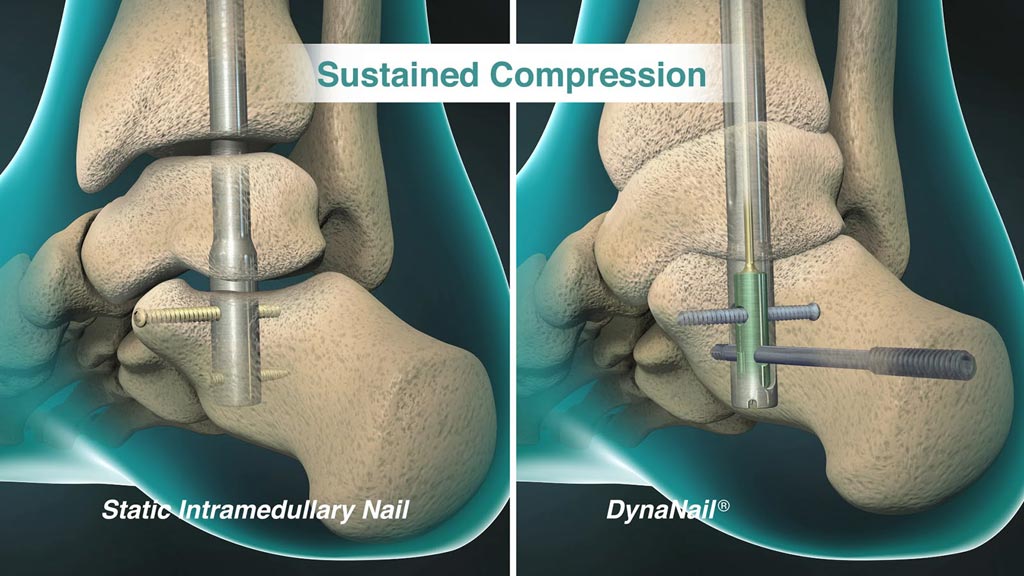Compressive Intramedullary Nail Promotes Bone Healing
|
By HospiMedica International staff writers Posted on 22 Jan 2018 |

Image: The DynaNail XL internal compressive element automatically adapts to changes in the joint (Photo courtesy of MedShape).
An internal fusion device harnesses the pseudoelastic properties of nickel-titanium (NiTiNOL) to provide the compression performance of an external frame inside an intramedullary nail design.
The MedShape (Atlanta, GA, USA) DynaNail XL tibiotalocalcaneal (TTC) fusion system features an internal NiTiNOL compressive element that maintains post-operative compression in order to accommodate for up to six mm of bone resorption and settling. The compressive element also allows for effective load sharing across the bone due to axial compliance during weightbearing. Similar to the original 220 mm version, the DynaNail XL--which is available in 260mm and 300mm lengths--also has a proximal taper for easy insertion through the tibial isthmus and an extra proximal screw hole for an optional cortical screw for additional stability.
The DynaNail XL, however, better accommodates longer patient tibial anatomies, or if tibial fractures are noted. According to the company, its longer length, in combination with the pseudoelastic internal NiTiNOL compressive element, could help reduce stress risers in the bone, consequently lowering the chance for tibial fractures. The proprietary DynaFrame Carbon-Fiber deployment system provides a simple, robust method to insert the DynaNail and activate the NiTiNOL element during surgery, which also facilitates automatic dynamization once the NiTiNOL element has fully recovered.
“The recent additions to the DynaNail portfolio demonstrate our continued commitment toward improving upon the success of the company’s flagship product,” said Kurt Jacobus, CEO of MedShape. “We have been pleased with the growing adoption of this unique technology by both orthopedic surgeons and podiatrists, and anticipate continued growth with these new offerings.”
An intramedullary nail is a metal rod forced into the medullary cavity of a bone, which forms a self-contained internal splint in order to stabilize the fracture. This is often done for fractures of the tibia, femur, and humerus. Advantages include more exact alignment of the fractured bones for faster healing and earlier weight-bearing, earlier joint motion for reduced stiffness, and a more natural-like motion in uninjured muscles and neighboring joints.
Related Links:
MedShape
The MedShape (Atlanta, GA, USA) DynaNail XL tibiotalocalcaneal (TTC) fusion system features an internal NiTiNOL compressive element that maintains post-operative compression in order to accommodate for up to six mm of bone resorption and settling. The compressive element also allows for effective load sharing across the bone due to axial compliance during weightbearing. Similar to the original 220 mm version, the DynaNail XL--which is available in 260mm and 300mm lengths--also has a proximal taper for easy insertion through the tibial isthmus and an extra proximal screw hole for an optional cortical screw for additional stability.
The DynaNail XL, however, better accommodates longer patient tibial anatomies, or if tibial fractures are noted. According to the company, its longer length, in combination with the pseudoelastic internal NiTiNOL compressive element, could help reduce stress risers in the bone, consequently lowering the chance for tibial fractures. The proprietary DynaFrame Carbon-Fiber deployment system provides a simple, robust method to insert the DynaNail and activate the NiTiNOL element during surgery, which also facilitates automatic dynamization once the NiTiNOL element has fully recovered.
“The recent additions to the DynaNail portfolio demonstrate our continued commitment toward improving upon the success of the company’s flagship product,” said Kurt Jacobus, CEO of MedShape. “We have been pleased with the growing adoption of this unique technology by both orthopedic surgeons and podiatrists, and anticipate continued growth with these new offerings.”
An intramedullary nail is a metal rod forced into the medullary cavity of a bone, which forms a self-contained internal splint in order to stabilize the fracture. This is often done for fractures of the tibia, femur, and humerus. Advantages include more exact alignment of the fractured bones for faster healing and earlier weight-bearing, earlier joint motion for reduced stiffness, and a more natural-like motion in uninjured muscles and neighboring joints.
Related Links:
MedShape
Latest Surgical Techniques News
- Novel Glue Prevents Complications After Breast Cancer Surgery
- Breakthrough Brain Implant Enables Safer and More Precise Drug Delivery
- Bioadhesive Sponge Stops Uncontrolled Internal Bleeding During Surgery
- Revolutionary Nano Bone Material to Accelerate Surgery and Healing
- Superior Orthopedic Implants Combat Infections and Quicken Healing After Surgery
- Laser-Based Technique Eliminates Pancreatic Tumors While Protecting Healthy Tissue
- Surgical Treatment of Severe Carotid Artery Stenosis Benefits Blood-Brain Barrier
- Revolutionary Reusable Duodenoscope Introduces 68-Minute Sterilization
- World's First Transcatheter Smart Implant Monitors and Treats Congestion in Heart Failure
- Hybrid Endoscope Marks Breakthrough in Surgical Visualization
- Robot-Assisted Bronchoscope Diagnoses Tiniest and Hardest to Reach Lung Tumors
- Diamond-Titanium Device Paves Way for Smart Implants that Warn of Disease Progression
- 3D Printable Bio-Active Glass Could Serve as Bone Replacement Material
- Spider-Inspired Magnetic Soft Robots to Perform Minimally Invasive GI Tract Procedures
- Micro Imaging Device Paired with Endoscope Spots Cancers at Earlier Stage
- AI Spine Model Could Reduce Surgical Risks
Channels
Critical Care
view channel
Origami Robots to Deliver Medicine Less Invasively and More Effectively
Delivering medicine to ulcers or other internal sites often requires invasive procedures that can disrupt surrounding tissues and lengthen recovery times. Traditional magnetic actuators used in soft robotics... Read more
Improved Cough-Detection Technology Aids Health Monitoring
Coughing serves as an important biomarker for tracking a variety of conditions and can help monitor the progress of respiratory diseases or predict when someone’s asthma is being exacerbated.... Read morePatient Care
view channel
Revolutionary Automatic IV-Line Flushing Device to Enhance Infusion Care
More than 80% of in-hospital patients receive intravenous (IV) therapy. Every dose of IV medicine delivered in a small volume (<250 mL) infusion bag should be followed by subsequent flushing to ensure... Read more
VR Training Tool Combats Contamination of Portable Medical Equipment
Healthcare-associated infections (HAIs) impact one in every 31 patients, cause nearly 100,000 deaths each year, and cost USD 28.4 billion in direct medical expenses. Notably, up to 75% of these infections... Read more
Portable Biosensor Platform to Reduce Hospital-Acquired Infections
Approximately 4 million patients in the European Union acquire healthcare-associated infections (HAIs) or nosocomial infections each year, with around 37,000 deaths directly resulting from these infections,... Read moreFirst-Of-Its-Kind Portable Germicidal Light Technology Disinfects High-Touch Clinical Surfaces in Seconds
Reducing healthcare-acquired infections (HAIs) remains a pressing issue within global healthcare systems. In the United States alone, 1.7 million patients contract HAIs annually, leading to approximately... Read moreHealth IT
view channel
Printable Molecule-Selective Nanoparticles Enable Mass Production of Wearable Biosensors
The future of medicine is likely to focus on the personalization of healthcare—understanding exactly what an individual requires and delivering the appropriate combination of nutrients, metabolites, and... Read moreBusiness
view channel
Philips and Masimo Partner to Advance Patient Monitoring Measurement Technologies
Royal Philips (Amsterdam, Netherlands) and Masimo (Irvine, California, USA) have renewed their multi-year strategic collaboration, combining Philips’ expertise in patient monitoring with Masimo’s noninvasive... Read more
B. Braun Acquires Digital Microsurgery Company True Digital Surgery
The high-end microsurgery market in neurosurgery, spine, and ENT is undergoing a significant transformation. Traditional analog microscopes are giving way to digital exoscopes, which provide improved visualization,... Read more
CMEF 2025 to Promote Holistic and High-Quality Development of Medical and Health Industry
The 92nd China International Medical Equipment Fair (CMEF 2025) Autumn Exhibition is scheduled to be held from September 26 to 29 at the China Import and Export Fair Complex (Canton Fair Complex) in Guangzhou.... Read more














